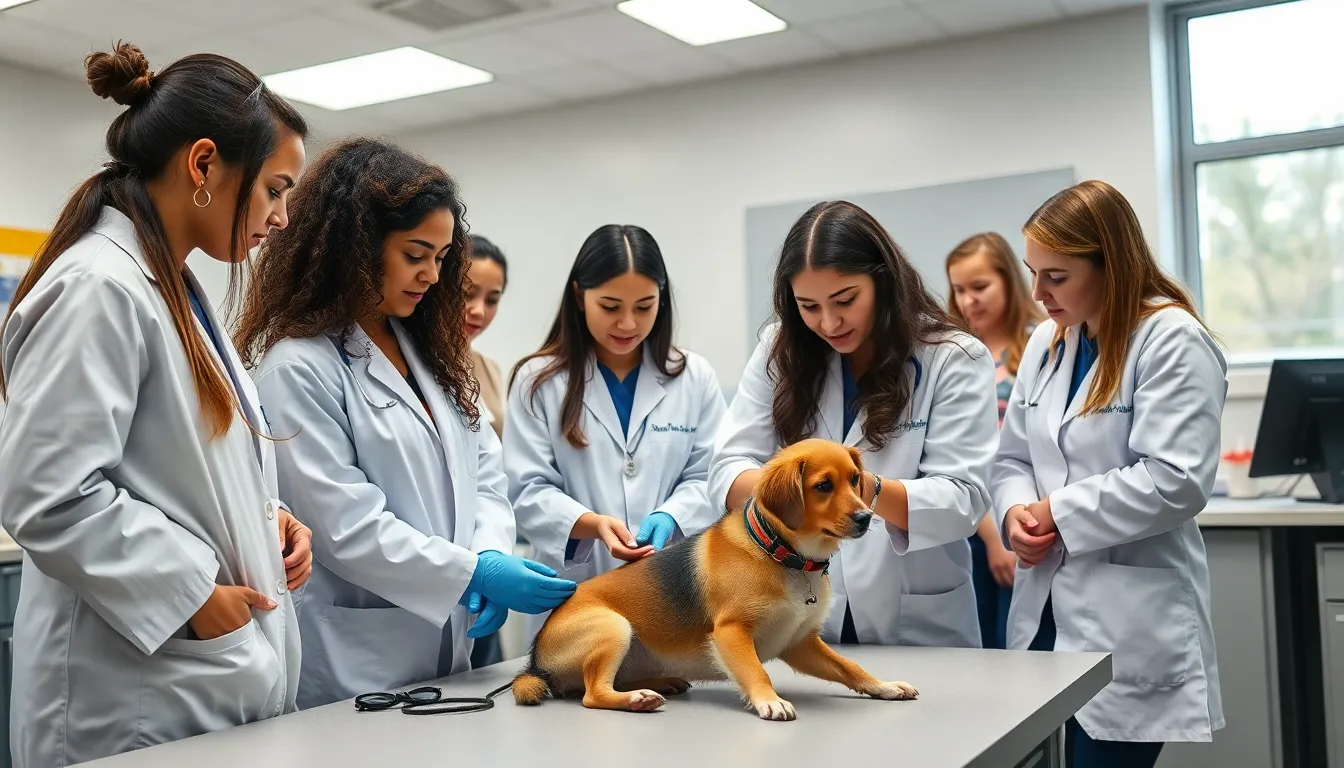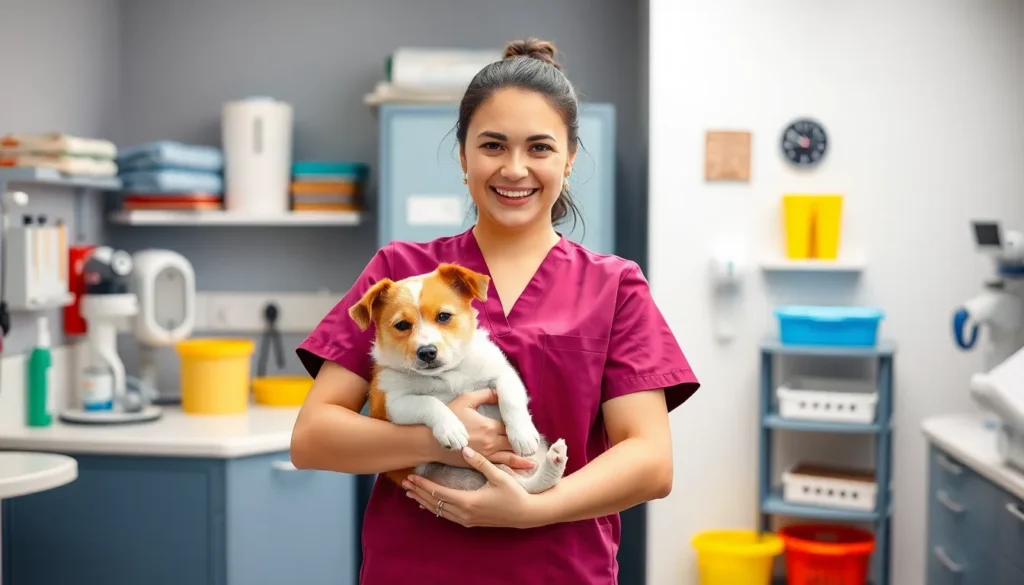Ever wondered how long it takes to become a vet tech? Spoiler alert: it’s not as long as waiting for your cat to come down from that tree. In the world of animal care, vet techs are the unsung heroes, juggling everything from administering vaccines to comforting anxious pups. But before you can don that scrubs uniform and start your journey into the furry side of healthcare, you’ll need to know the timeline.
Table of Contents
ToggleOverview of Vet Tech Career
A veterinary technician plays a crucial role in animal health care, providing essential support to veterinarians. Responsibilities include administering medications, assisting in surgeries, and conducting diagnostic tests. Individuals in this profession work in various settings, such as animal hospitals, clinics, and research facilities.
Educational requirements typically involve completing an accredited veterinary technology program. Most programs take about two years to finish, which includes both classroom instruction and hands-on training. After education, aspiring vet techs must pass the Veterinary Technician National Examination (VTNE) to obtain licensure.
Job prospects for veterinary technicians remain strong. The Bureau of Labor Statistics projects an annual job growth rate of 20% for vet techs from 2021 to 2031. Many employers seek candidates with formal education, clinical experience, and a passion for animal care.
Salary ranges for veterinary technicians vary based on location, experience, and facility type. On average, veterinary technicians earn annual salaries between $34,000 and $48,000. Areas with high demand, such as urban centers, often offer higher salaries.
Career advancement opportunities exist for individuals who pursue specialties, such as emergency and critical care or anesthesia. Continuing education helps vet techs stay updated on the latest practices and technologies in animal care.
Overall, the path to becoming a vet tech is relatively straightforward and rewarding, allowing passionate individuals to make a meaningful impact on animal health and welfare.
Educational Requirements

Becoming a veterinary technician involves several educational steps and credentials. These requirements ensure that candidates gain the necessary skills for this vital profession.
High School Diploma
A high school diploma serves as the foundational step for aspiring vet techs. Coursework in subjects like biology, chemistry, and animal science provides a solid prelude to veterinary technology studies. Many programs emphasize the importance of science and math, preparing students for more advanced education. Individuals who excel in these subjects often find that their skills translate well into the veterinary field. Some high schools may offer vocational programs, granting students early exposure to animal care. Overall, a strong academic background lays the groundwork for specialized training.
Associate Degree
An associate degree in veterinary technology is essential for obtaining licensure. This two-year program usually includes both coursework and hands-on clinical experience. Students learn vital skills such as administering medications, performing laboratory tests, and assisting in surgical procedures. Accreditation from the American Veterinary Medical Association (AVMA) ensures that the program meets industry standards. Graduates become eligible to sit for the Veterinary Technician National Examination (VTNE), which is necessary for state licensure. Completing this degree often leads to improved job prospects thanks to the rigorous training involved.
Certification Process
The certification process for becoming a vet tech requires specific steps to ensure competency in the field.
National Veterinary Technician Exam (NVTE)
The National Veterinary Technician Exam (NVTE) serves as a crucial milestone. Candidates must pass this exam to demonstrate their knowledge and skills in veterinary technology. It consists of multiple-choice questions covering essential veterinary topics. A passing score indicates readiness for professional practice, allowing candidates to exhibit competence in animal care and medical principles. Preparation for the NVTE typically includes reviewing coursework and clinical experiences. Graduates of AVMA-accredited programs are eligible to register and schedule their exam date.
State Licensing Requirements
State licensing requirements vary, making it important for aspiring vet techs to understand local regulations. Each state has its own board that oversees licensing, and applications often require proof of graduation from an accredited program. Background checks and transcripts are standard parts of the application process. Some states may necessitate additional examinations or continuing education courses for licensure maintenance. Compliance with state-specific regulations is essential for practicing legally and effectively in veterinary settings. Adhering to these requirements positions vet techs for success and enhances their career prospects.
Factors Affecting Timeframe
Several aspects influence the time it takes to become a veterinary technician, shaping the overall journey.
Full-Time vs Part-Time Study
Full-time study programs typically last two years, allowing students to complete the necessary coursework quickly. Part-time options extend the duration, averaging three to four years due to reduced class loads. Students need to balance work or personal commitments when choosing part-time study. Accreditation from the American Veterinary Medical Association ensures quality education, regardless of the study format selected. Both pathways lead to eligibility for the Veterinary Technician National Examination, crucial for licensure.
Previous Experience
Previous experience in animal care can significantly shorten the learning curve. Students with clinical experience may grasp practical skills faster during their educational programs. Volunteer roles at animal shelters or work as veterinary assistants provide valuable insights into the field. Such experiences enhance their resumes, making candidates more appealing to employers upon graduation. Familiarity with veterinary practices allows for smoother transitions into both coursework and clinical components of the program.
Job Outlook and Prospects
Job prospects for veterinary technicians remain strong, with a projected annual growth rate of 20% from 2021 to 2031. This demand reflects the increasing need for animal care professionals in various settings, including clinics and research facilities. Salary ranges for vet techs typically fall between $34,000 and $48,000, influenced by geographical location and experience level. Urban areas often offer higher salaries due to increased living costs and demand.
Advancement opportunities exist for those in the field willing to pursue specialties or further education. Specialized roles within veterinary technology can lead to both higher earning potential and increased job satisfaction. Furthermore, continuing education plays a crucial role in maintaining licensure and keeping up with industry advancements.
Employment settings also affect job prospects. Vet techs find opportunities in animal hospitals, private clinics, and research institutes, each offering unique experiences. Those with additional certifications or training often attract more job offers.
Animal welfare organizations increasingly recognize the importance of vet techs, further expanding job availability. As pet ownership rises, the demand for trained professionals to assist veterinarians also grows, solidifying the role of vet techs in animal healthcare.
Overall, career trajectories for veterinary technicians present clear pathways for both entry-level positions and long-term growth, making this profession a viable choice for those passionate about animal health and welfare.
Becoming a veterinary technician is a fulfilling journey that typically takes two years of dedicated study. With strong job prospects and a growing demand for animal care professionals, aspiring vet techs can look forward to a rewarding career. The combination of hands-on experience and specialized training prepares them for various roles in the field. Whether working in animal hospitals or research facilities, vet techs play a vital role in ensuring the health and well-being of pets. As the profession continues to evolve, those who pursue this path can expect ample opportunities for growth and advancement.








